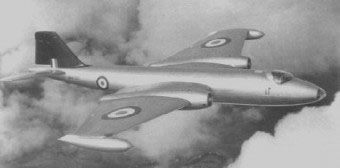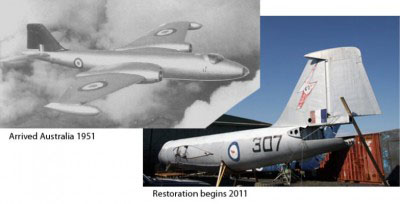A84-307 was constructed in July 1951 as a B1 bomber version of the English Electric Canberra and purchased at that time by the Australian government.
In August 1951, A84-307 was flown to RAAF Laverton in Victoria where it was taken on charge by the RAAF.
A84-307 is the first Canberra to see service with the RAAF.The aircraft was issued to the Aircraft Research and Development Unit (ARDU) where it subsequently undertook many high altitude, high speed test flights over a five year period. These tests were designed to give the RAAF its first understanding of high altitude airframes and jet engine design.

Late in 1956, A84-370 suffered serious damage in a mid-air incident. Although the aircraft was able to reach ground safely, both wings were so severely damaged that they needed to be replaced. Whilst the wings were removed, it was decided to convert the aircraft to an Mk21 trainer version, a process that took two years over 1957-58.
In November 1958, A84-307 was issued to No6 squadron Amberley where it operated until 1964. The aircraft was then transferred to RAAF Butterworth in Malaya where from 1964 – 1966 it took part in continuation training and instrument rating tests for crews operating over Indonesia during their confrontation with Communist forces. During this period A84-307 received further modification as part of the clandestine Transport Support Flight (TFS) and took part in the Lone Ranger missions to Hong Kong as bomber versions of the Canberra were not allowed to operate outside Malaysia.
No 2 Sqn RAAF was deployed to Phan Rang Air Base in South Vietnam in April 1967, 307 remained as part of TFS for instrument rating tests of pilots at Phan Rang. 307 deployed to Phan Rang for one or two week periods for the instrument rating tests by QFIs. A84-307 returned to Australia in late 1968 for a major overhaul after which it was allocated to No1 Bomber Operational Conversion Unit for 2 Sqn crews in Phan Rang. A84-307 was retired from squadron service in August 1973 and allocated to No1 CAMD at Kingswood for static display at which time it became the sole surviving example of a dual control (two pilot) model in the world.
After years of stagnation since its phase out from service in 1973 a capable and experienced aircraft restorer, Colin Grey OAM, rescued the Canberra from the scrap heap at a decommissioned airfield at Kemps Creek NSW. Colin estimated it would take about six years to complete a full restoration of the bomber, which he has gifted to the National Vietnam Veterans Museum.
The restoration of this aircraft will entail the removal of all fixtures, fittings and furnishings from the airframe. The airframe will then need to be broken down to its major componentry and then each component broken down as condition requires. Although the airframe looks reasonably sound from the exterior the airframe is made up of mixed aluminium alloys, alloy steels and other dissimilar metals which over time have reacted with each other to form highly corrosive oxides. In particular, the many thousands of parts manufactured from magnesium alloy (magnesium is euphemistically known as magic metal for its ability to disappear) a very light but strong material that is susceptible to corrosion thus has a very short operational life. Therefore, virtually every component of the airframe will have to be dismantled to be refurbished, repaired and replaced.
To undertake this work a multitude of workshop equipment, fixtures, jigs and other equipment will need to be constructed to facilitate the restoration. A wide range of specialised pneumatic tools to work with the various alloys present are also needed. By virtue of their type, design and construction this equipment and these tools are highly specialised with many needing to be built from scratch by our volunteers.
Work is currently underway to remove all of the fixtures, fittings and furnishing from the forward section of the fuselage. For the most part these are complete and in reasonable condition. However, the alloy components of many of the pieces have been riveted together with magnesium alloy rivets and all structural strength has wasted away. In this case a paint strip, de-corrosive process, reassembly with aluminium alloy rivets and a new finish with appropriate paints and finishes will complete the restoration work.
Also located at the museum is a collection of tools and metal machining equipment required for use on the restoration. The long duration of the project would require the Canberra being in place at the museum during restoration and this necessitated the need to provide suitable covered accommodation for the Canberra for both restoration and public viewing. Members of the local Oceania Aviation Museum, who had successfully completed a Japanese Zero Fighter project for use in a movie, have undertaken the restoration of the Canberra.
This job is going to be expensive. A variety of funding options (grants and sponsorships) will be activated as the project progressively unfolds, including permitting public access to view the restoration. Albeit the bomber will never again be airworthy, both of the Rolls Royce Avon jet engines have been refurbished as part of the restoration process. By any measure A84-307 is an historic aircraft worthy of museum display, but it is its Vietnam association that warrants its place in the National Vietnam Veterans Museum.

Contact Ken Anderson about this article.






